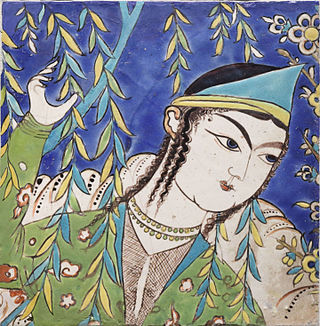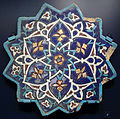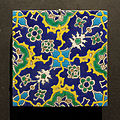Top Qs
Timeline
Chat
Perspective
Cuerda seca
Technique for applying colored glazes to ceramics From Wikipedia, the free encyclopedia
Remove ads
Cuerda seca (Spanish for "dry cord") is a technique used when applying coloured glazes to ceramic surfaces.

Description
When different coloured glazes are applied to a ceramic surface, the glazes have a tendency to run together during the firing process. In the cuerda seca technique, the water-soluble glazes are separated on the surface by thin lines of a greasy substance to prevent them running out of their delineated areas. A dark pigment such as manganese carbonate is usually mixed with the grease to produce a dark line around each coloured area.[1]
Remove ads
History
Summarize
Perspective
The origin of the technique is not known for certain. Many scholars believe that the cuerda seca technique originated primarily in al-Andalus (Islamic Spain and Portugal) in the second half of the 10th century, during the Umayyad period (citing Umayyad-era examples from Suza).[2][3][4][5] Scholar Juan Zozaya argues that the advent of this style in al-Andalus could have been spurred by Chinese ceramics which were imported to the region from an early period.[6] The technique was further advanced during the Taifas period in the 11th century.[3] Preserved fragments of tiles from the late 12th-century minaret of the Kasbah Mosque in Marrakesh, Morocco, have been cited as the earliest surviving example of cuerda seca tilework being used for architectural decoration.[5]

In Central Asia, Haft-rang ("seven colors") enamelled tiles were manufactured using the cuerda seca technique from the second half of the 14th century.[8] Hans Van Lemmen postulates that these tiles, from the Timurid period (late 14th to 15th centuries), were the "earliest development of cuerda seca".[9] The introduction of different coloured glazes is recorded in the mausoleums of the Shah-i-Zinda necropolis in Samarkand. In the 1360s the colours were restricted to white, turquoise and cobalt blue but by 1386 the palette had been expanded to include yellow, light-green and unglazed red.[10] Large quantities of cuerda seca tiles were produced during the Timurid (1370–1507) and Safavid (1501–1736) periods.[11]
In the 15th century Persian potters from Tabriz introduced the technique into Turkey and were responsible for decorating the Yeşil Mosque in Bursa (1419-1424).[12] Within the Ottoman Empire cuerda seca tilework fell out of fashion in the 1550s and new imperial buildings were decorated with underglaze-painted tiles from İznik. The last building in Istanbul to include cuerda seca tilework was the Kara Ahmed Pasha Mosque which was designed in 1555 but only completed in 1572.[13][14]
Remove ads
Gallery
- Cuerda seca tile from the Alcazar of Seville, 12th-13th century
- Tiles in the Green Mosque, Bursa, c. 1420
- Details of the Green Tomb in Bursa
- Tile from Khargird in Iran, mid 15th century
- Ottoman tile, Istanbul, first half 16th century
- Dish from Seville in Spain, early 16th century
Notes
Sources
Further reading
External links
Wikiwand - on
Seamless Wikipedia browsing. On steroids.
Remove ads







